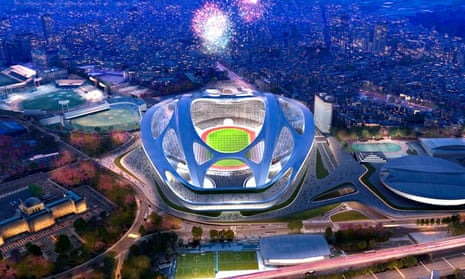Zaha Hadid has stoked an international row over her design for Tokyo’s 2020 Olympic and Paralympic stadium by branding eminent Japanese architects who criticised her scheme as hypocrites.
The Iraqi-born, London-based architect hit back after two years of complaints about her design for a 80,000 seat arena by some of Japan’s leading architects that included warnings it would be “a monumental mistake” and “just ridiculous”.
The stadium, which Japanese architect Arata Isozaki said looked “like a turtle waiting for Japan to sink so that it can swim away”, has been highly controversial in Japan, partly because of its huge form rising 70 metres above the low rise buildings close to the historic Meiji shrine, but also because of its £1.8bn budget which was slashed by the government last year to £970m. Pritzker prize-winning architect Fumihiko Maki, 86, organised a symposium to protest against the scheme, and was joined by fellow leading Japanese architects Toyo Ito, Kengo Kuma and Sou Fujimoto. A petition calling for the project to be scrapped has gained 33,000 signatures of support.
Speaking at the groundbreaking of her 1000 Museum skyscraper in Miami on Friday, Hadid told Dezeen magazine she was saddened by the attacks which she claimed were motivated by not wanting a foreigner to build in Tokyo. Hadid designed the aquatics centre for the London 2012 Olympics and has designed the Al Wakrah stadium for the football World Cup in Qatar in 2022.
“I think it’s embarrassing for them,” she said. “Many of them were friends of mine, actually the ones which I supported before like Toyo Ito, who I worked with on a project in London. I’ve known him for a long time.
“I understand it’s their town. But they’re hypocrites because if they are against the idea of doing a stadium on that site, I don’t think they should have entered the competition. The fact that they lost is their problem.
“They don’t want a foreigner to build in Tokyo for a national stadium. On the other hand, they all have work abroad. Whether it’s Sejima, Toyo Ito, or Maki or Isozaki or Kengo Kuma.”
Last month Isozaki, 83, wrote an open letter to the Japan Sports Council, the government body in charge of plans for the 2020 Games, in which he attacked the “distorted” process that has led to “a dull, slow form”.
“The sight left me in despair,” he wrote, having seen Hadid’s revised scheme at an exhibition at the Tokyo Opera City Art Gallery. “If the stadium gets built the way it is, Tokyo will surely be burdened with a gigantic white elephant.”
“It’s just ridiculous,” said Maki, who designed the National Gymnasium in 1990, over which Hadid’s scheme will loom. “We are raising our voices, but they don’t listen. We are not a civil society where citizen’s voices can be critical.”
Last year 100 people, led by Maki, signed a petition asking the Japanese government to slim down the stadium. It said: “Given a total floor space double to triple the past main Olympics venues such as London and Athens, we are also concerned about its costs for safety, maintenance and management.”
Several Japanese architects were among the 11 finalists in the competition to design the stadium, including Toyo Ito, SANAA with Nikken Sekkei, Azusa Sekkei, and Mitsuru Man Senda and Environment Design Institute. Leading Japanese architect Tadao Ando led the judging panel that selected Hadid in 2012. At the time he said the “dynamic and futuristic design embodies the messages Japan would like to convey to the rest of the world”.
Hadid said: “The design is both light and cohesive, seamlessly connecting the stadium’s different elements to create a silhouette that integrates with the city.”

Comments (…)
Sign in or create your Guardian account to join the discussion